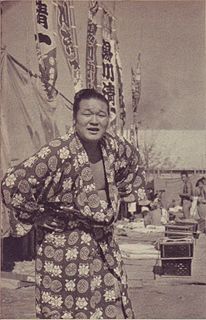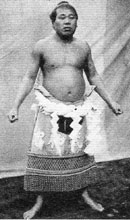 W
WAkua Shōma is a Japanese professional sumo wrestler from Ibaraki Prefecture. He made his debut in November 2010 and reached the top makuuchi division in November 2020, just after turning 30 years of age. He wrestles for Tatsunami stable. His highest rank is maegashira 13. His shikona is a reference to the Aqua World aquarium in his home town.
 W
WAsashio Tarō I was a sumo wrestler from Ehime Prefecture, Japan. His highest rank was ozeki.
 W
WAyagawa Gorōji was a Japanese sumo wrestler, who is formally recognised as the second yokozuna.
 W
WHetal Dave is India's first and only professional female sumo wrestler. In 2008, the woman from Mumbai made it into the Limca Book of Records.
 W
WDewanohana Kuniichi born as Kuniichi Ichikawa in Komatsu, Ishikawa, Japan was a sumo wrestler, whose highest rank was maegashira 1. He was chairman (rijichō) of the Japan Sumo Association from 1968 to 1974. Unlike most of his contemporaries, he had a business education background.
 W
WFusanishiki Katsuhiko was a sumo wrestler from Ichikawa, Chiba, Japan. He made his professional debut in January 1952 and reached the top division in May 1957. His highest rank was sekiwake. Upon retirement from active competition, he became an elder in the Japan Sumo Association. He married the daughter of his stable master, ex-maegashira Shachinosato. He was head coach at Wakamatsu stable from 1979 until 1990, when he left the Sumo Association because of poor health. Former ōzeki Asashio Tarō IV took over as Wakamatsu's head coach in March 1990.
 W
WIwakaze Kakutaro was a sumo wrestler from Tokyo, Japan. He made his professional debut in May 1952 and reached the top division in May 1956. His highest rank was sekiwake. He retired from active competition in September 1965.
 W
WKanenohana Takeo is a former sumo wrestler from Yokohama, Kanagawa, Japan. He made his professional debut in May 1952 and reached the top division in March 1958. His highest rank was komusubi. He left the sumo world upon retirement from active competition in September 1967.
 W
WKashiwado Risuke was a sumo wrestler from Goshogawara, Aomori, Japan.
 W
WKitaseumi Hiromitsu is a former sumo wrestler from Kitahiyama, Hokkaidō, Japan. He made his professional debut in July 1964, and reached the top division in March 1972. His highest rank was sekiwake. He retired in May 1979 and was active elder in the Japan Sumo Association under the name Kimigahama. As Kimigahama-oyakata he first coached at Kokonoe stable, but moved to Hakkaku stable when it was started up by former Kokonoe wrestler Hokutoumi in 1993. He reached the Sumo Association's mandatory retirement age of 65 in July 2013. The Kimigahama toshiyori-kabu was acquired by Hakkaku wrestler Okinoumi in October 2013.
 W
WKotogahama Sadao was a sumo wrestler from Kanonji, Kagawa, Japan.
 W
WKotonishiki Noboru was a sumo wrestler and coach from Kanonji, Kagawa, Japan. His highest rank was komusubi. He was runner-up in the January 1949 tournament and earned seven gold stars for defeating yokozuna. After his retirement in 1955 he founded the Sadogatake stable and produced yokozuna Kotozakura among others. He ran the stable until his death in 1974.
 W
WKurosegawa Kuniyuki is a former sumo wrestler from Higashimurayama, Tokyo, Japan. He made his professional debut in January 1966, and reached the top division in May 1978. His highest rank was komusubi. He retired in May 1984 and became an elder in the Japan Sumo Association under the name Kiriyama. In 1995 he branched out from Isegahama stable and established his own Kiriyama stable, which shut down in 2011. He reached the mandatory retirement age of 65 in May 2016, but was re-hired by the Sumo Association for five years as a consultant. In September 2016 he was re-appointed as a judge of tournament bouts, following the demotion of Kasugayama. He left the Sumo Association upon turning 70 in May 2021.
 W
WMaedagawa Katsu was a sumo wrestler from Esashi, Iwate, Japan. He made his professional debut in September 1952, and reached the top division in November 1960. His highest rank was sekiwake. He retired from active competition in May 1967.
 W
WMaruyama Gondazaemon was a Japanese sumo wrestler, who is formally recognised as the third yokozuna. His real name was Haga Gindayu . He came from Mutsu Province in the Sendai Domain.
 W
WMatsunobori Shigeo was a sumo wrestler from Matsudo Chiba, Japan. He fought for the now defunct Ōyama stable, joining in 1941. He reached the top makuuchi division in 1951 and made the second highest ōzeki rank in 1956, after finishing as a runner-up to Kagamisato in the September 1955 tournament. He was an ōzeki for fifteen tournaments, although he lost the rank at the end of 1958. He retired in November 1961, and in his role as an elder of the Japan Sumo Association he became the head of Ōyama stable in January 1962 upon the death of his old stablemaster, ex-sekiwake Takanobori. He produced one sekitori, the maegashira Daihi, who retired in 1983. Shortly after Ōyama's death in April 1986 the stable was wound up and its two remaining wrestlers retired.
 W
WMiyagino Nishikinosuke was a Japanese sumo wrestler. His highest rank was sekiwake. He was an active top makuuchi division wrestler at the age of 52, which is the all-time recognized record.
 W
WNomi no Sukune or Nomino Sukune was a Japanese legendary sumo wrestler during the Emperor Suinin era. Allegedly, in 23 B.C., the Emperor instructed Nomi no Sukune to deal with Taima no Kehaya (当麻蹴速) after he boasted that he was the strongest man "under the heavens." Nomi no Sukune engaged Taima no Kuyahaya in hand-to-hand combat and broke his ribs with one kick and his back with another, killing Taima no Kehaya. It was not modern sumo, but he is regarded as the human creator of sumo. He was an ancestor of Sugawara no Michizane, great-grandfather to Haji no Mino and was the founder of the Haji Clan after his creation of haniwa.
 W
WOginohana Masaaki was a sumo wrestler from Ogi, Saga, Japan. He made his professional debut in 1952 and reached the top makuuchi division in 1957. His highest rank was sekiwake. He retired in 1967 and worked as a coach at Dewanoumi stable before leaving the Sumo Association in 2000 upon reaching the mandatory retirement age of 65. He was the father of Oginohana Akikazu and Oginishiki Yasutoshi, both successful sumo wrestlers themselves.
 W
WOikawa Teruhisa is a former sumo wrestler from Maesawa, Iwate, Japan. He made his professional debut in January 1952 and reached the top division in September 1957. His highest rank was maegashira 10. He retired from active competition in May 1962.
 W
WOiteyama Hirokuni, born Mitsugu Yamaguchi, was a sumo wrestler from Goshogawara, Aomori, Japan. He made his professional debut in May 1953 and reached the top division in May 1960. His highest rank was maegashira 6. Upon retirement from active competition he became an elder in the Japan Sumo Association. He reached the Sumo Association's mandatory retirement age of 65 in June 2003.
 W
WŌkido Moriemon was a Japanese professional sumo wrestler. He was the sport's 23rd yokozuna. He was the second yokozuna to be recognised from Osaka sumo, and the only yokozuna who spent his whole active career in the city.
 W
WRyōgoku Kajinosuke II was a Japanese sumo wrestler. His highest rank was sekiwake.
 W
WTakamiyama Torinosuke was a Japanese sumo wrestler.
 W
WTamagaki Gakunosuke IV was a Japanese sumo wrestler from Minamitakaki, Nagasaki, Japan. His highest rank was ōzeki.
 W
WTamatsubaki Kentarō was a sumo wrestler from Toyama City, Japan. He was known for his techniques, which accommodated his small size. Although his height was only 158 cm, he gave the likes of Hitachiyama and others a real challenge and was called the "mite". He was the shortest wrestler in sumo history, and also one of the lightest at 73 kg. His highest rank was sekiwake. After retirement he was known as Shiratama-oyakata.
 W
WTenryū Saburō, born Saburō Wakuta in Shizuoka Prefecture, Japan, was a professional sumo wrestler with the Dewanoumi stable. As the ringleader of the "Shunjūen Incident", in which many wrestlers went on strike, he left the Japan Sumo Association in 1932. With the other striking wrestlers, he created the "Rishiki group for a Great Japan", wishing to reform the system he described as "feudal" and to increase his earnings. Because of financial difficulties, the group dissolved in 1937.
 W
WTochihikari Masayuki was a sumo wrestler from Kumamoto Prefecture in Japan who reached the second highest rank of ōzeki in 1962. He joined Kasugano stable in 1952 and reached the top makuuchi division in 1955. He never won a top division championship but was a tournament runner-up four times. He was promoted to ōzeki in May 1962 alongside his stablemate Tochinoumi. He fought as an ōzeki for 22 tournaments but lost the rank after recording three consecutive losing scores and immediately announced his retirement in January 1966. He became an elder of the Japan Sumo Association under the name Chiganoura. He was a judge of tournament bouts and was involved in both the incorrect decision to award a win to Toda that stopped Taiho's 45 bout winning streak in March 1969 and the famous decision in January 1972 to declare Kitanofuji the winner over Takanohana by kabai-te. He died of rectal cancer at the age of 43. His shikona of Tochihikari was subsequently used by a later wrestler from Kasugano stable, also known as Kaneshiro Kofuku.
 W
WToyokuni Susumu is a former sumo wrestler from Nakatsu, Ōita, Japan. He made his professional debut in May 1960, and reached the top division in November 1961. He earned seven gold stars against grand champion yokozuna in the course of his career. His highest rank was komusubi. He retired in January 1968.
 W
WWakachichibu Komei was a sumo wrestler from Chichibu, Saitama, Japan. He made his professional debut in May 1954 and reached the top division in September 1958. His highest rank was sekiwake. Upon retirement from active competition he became an elder in the Japan Sumo Association, under the name Tokiwayama. He reached the Sumo Association's mandatory retirement age in March 2004.
 W
WWakasugiyama Toyoichi was a sumo wrestler from Shime, Fukuoka, Japan. He made his professional debut in March 1953, and reached the top division in March 1959. His highest rank was maegashira 1. He left the sumo world upon retirement from active competition in May 1967.